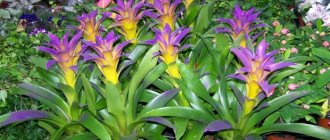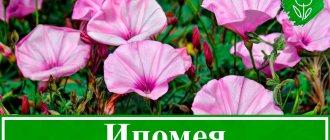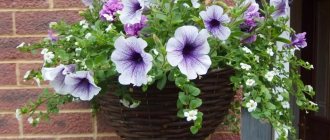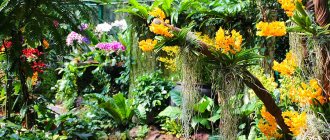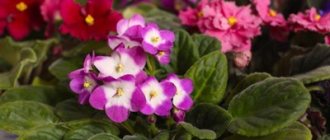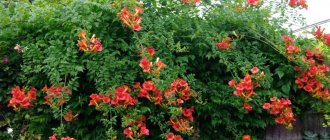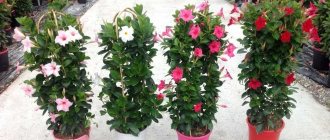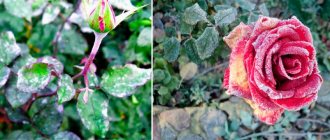Author: Elena N. https://floristics.info/ru/index.php?option=com_contact&view=contact&id=19 Category: Garden plants Published: February 10, 2019Last edits: November 03, 2020
- When to plant
- Growing conditions
- How and when to collect seeds
- Winged Thunbergia (Thunbergia alata)
liana (lat. Thunbergia) belongs to the genus of flowering plants of the Acanthaceae family, native to the tropics of Africa, Madagascar and southern Asia. There are about two hundred species in the genus. The Thunbergia flower received its scientific name in honor of the Swedish naturalist, researcher of the flora and fauna of Japan and South Africa, Carl Peter Thunberg. Thunbergia, or black-eyed Suzanne, as Europeans call it because of the dark purple, almost black eye in the middle of the flower, is cultivated both as a garden and as a houseplant.
Planting and caring for thunbergia
- Planting: sowing seeds for seedlings - at the end of winter or early spring, transplanting seedlings into the ground - in the second half of May.
- Flowering: abundant, from mid to late summer.
- Lighting: partial shade.
- Soil: nutritious, well-drained, containing lime, neutral reaction.
- Watering: moderate, during flowering – abundant. During drought, evening spraying is also recommended as needed.
- Feeding: once a month with a solution of mineral fertilizer.
- Garter: it is advisable to hang the plant on a wire or lattice.
- Reproduction: seed.
- Pests: aphids, whiteflies, spider mites and scale insects.
- Diseases: fungal, due to excessive soil moisture and poor air circulation.
Read more about growing thunbergia below.
Diseases
Sometimes the plant is affected by fungal diseases.
This disease is treated with fungicides.
Affected areas of leaves and flowers must be removed. Also, this representative of the flora can get sick from improper care .
If green mold appears on branches, flowers or leaves , you must stop spraying and watering. The plant is transplanted into new containers and the soil in them is replaced.
When shoots are exposed and leaves are growing poorly, the flower is rearranged or transplanted to a more illuminated place. Sparse growth of leaves indicates too shaded growth.
Botanical description
The thunbergia plant can be a vine or shrub with whole heart-shaped or ovate, as well as lobed opposite leaves with soft pubescence from 2.5 to 10 cm in length, in some species the edges of the leaves are serrated. Funnel-shaped beautiful thunbergia flowers up to 4 cm in diameter on long stalks, solitary or collected in inflorescences, have different colors - white, blue, indigo, violet, lilac, purple, yellow, orange or brown. There is even Thunbergia red. In some species and varieties, the flowers emit a strong aroma. Thunbergia blooms from July to the end of September.
In nature, Thunbergia is a perennial plant, but in our climate, growing Thunbergia in open ground as a perennial plant is impossible due to our cold winters, so Thunbergia climbing is cultivated as an annual plant and is often used for vertical gardening, since if there is support it grows up to two meters in height. height. But ampelous thunbergia is successfully grown as a perennial at home or in greenhouse conditions.
Description of the plant
Thunbergia is a tropical plant from the Acanthus family, native to Africa. Among the varieties of thunbergia you can find both annual and perennial climbing plants. In our climate, it is grown as an annual, although you can try to winterize it in a cool room.
Photo. What does thunbergia look like in warmer countries?
The name comes from the name of Carl Peter Thunberg, a Swedish botanist, doctor, traveler and writer, student of Linnaeus, who lived in 1743-1828.
The plant has very fast, lush growth and showy, brightly colored flowers with a black eye. The name of the plant is a literal translation of the Latin name into the botanical name.
There are also synonyms that reflect the characteristics of the flower. In German the vine is called: die Schwarzäugige Susanne = “black-eyed Susie”, in Swedish: svartöga = “black eyes”.
Botanical characteristics:
- Shoots - in our climate they grow up to 1-1.5 m in length, and can grow by 20 cm per week. When grown in containers in the best conditions they do not exceed 1.5 meters, usually 1 meter.
- The shoots twist around the supports counterclockwise.
- The leaves are medium-sized, opposite, reaching up to 7 cm in length, entire or lobed, heart-shaped, arrow-shaped or triangular, on long petioles, slightly pubescent with a wavy edge.
- The flowers are large, 3-4 cm in diameter, with a five-lobed crown, funnel-shaped, the flower crown forms an elongated tube, white, yellow, orange on the outside and very dark on the inside. The black eyes characteristic of the botanical species are not always found in modern varieties.
The flowering period of thunbergia is from May-June to October. If we have a hot summer, the plant limits flowering during the hot season and compensates a little later when it is a little cool but sunny.
In order for thunbergia to wrap around supports, it is worth planting it near gazebos and pergolas. If it just grows in a pot on the balcony, it will hang down beautifully.
Thunbergia is an extremely prolific flowering plant. In warm and sunny weather, real flower cascades develop. Whether the plant is a classic Thunbergia species with yellow, orange, pastel flowers or a completely new variety that blooms pink flowers, the vines create a dense curtain of leaves all summer long with cheerful, bright flowers in the background.
Thunbergia is sometimes used as a vegetable by the peoples of East Africa. Particularly sensitive people may experience skin irritation from the plant sap.
Growing thunbergia from seeds
How to sow seeds
Seed propagation of thunbergia occurs in late winter or early spring. The seeds are treated with epin or fumar and sown in containers with moist soil consisting of turf soil, peat and sand (or leaf soil, sand and humus) in equal proportions, sprinkled with a thin layer of soil, which is carefully moistened. To create a greenhouse effect, the crops are covered with glass or film and placed on a warm, well-lit windowsill, where direct sunlight does not reach. It is very important to ensure that the soil is slightly moist at all times.
- Tulip bulbs
The temperature for successful seed germination is 22-24 ºC. If all conditions are met, the seeds will begin to germinate within a week, and then the coating can be removed.
Seedling care
If the seedlings sprout densely, then when two true leaves appear, they need to be plucked or thinned out, leaving the strongest specimens in the container. When the seedlings reach a height of 12-15 cm, in order to enhance branching, the tops of the seedlings are pinched. If you want a powerful and dense green mass, feed the seedlings once a week from the moment of picking with nitrogen-containing fertilizer, but if you are hoping for lush and long-lasting flowering, do not fertilize the seedlings at all. For those who do not want to bother with picking thunbergia, it is better to sow it not in containers or boxes, but in peat cups with three seeds each.
How to grow thunbergia
Thunbergia is easy to care for. It is not difficult to grow it in the garden or indoors. Growing quickly, it will delight you with bright flowering for a long time.
Planting dates
In warm climates, the exotic vine is grown as a perennial. Our climate is more severe, so its cultivation is possible in open ground only as an annual.
The best option for breeding thunbergia is growing from seeds.
In the last winter month you need to prepare seeds for seedlings. They are sown in the third ten days of February. By the end of May, strong seedlings have grown, ready for planting in open ground. During June, the flower actively grows many shoots. If the seeds have not sprouted in February, this is not critical; they can be sown until the end of March.
Soil preparation
The soil for seedlings should be light and fertile. To sow seeds, prepare a soil substrate, which should include humus, leaf soil and sand.
Seedlings are planted in slightly acidic soil consisting of a mixture of peat, turf and leaf soil, and sand. Adding a small amount of lime before planting has a beneficial effect on plant growth.
Seed preparation
Thunbergia seeds are quite large and easy to work with. Before sowing, they must be soaked in a solution of a growth stimulator (Fumar, Epin). Some gardeners pre-germinate the seeds by placing them in a damp cotton cloth. Then they are planted with hatched sprouts in a container with soil. Others are sown dry in cups or peat tablets.
Planting (selection of capacity)
You can sow seeds in shallow boxes, or in peat pots. Thunbergia seeds are large, so they can be easily placed in the ground at a certain distance so that they do not have to be thinned out in the future. Sow no more than 3 seeds in cups; in boxes, the distance between the seed material should be at least 3-5 cm.
Planting stages
- Moisten the soil in the planting container; it is better to do this with a spray bottle, then the moistening will be uniform and will not blur the holes.
- The seeds should be deepened into the soil by 5-7 millimeters, or you can simply sprinkle them with a thin layer of soil on top.
- Cover the mini-greenhouses with transparent film, place them in a bright, warm place, the temperature should not be lower than +22 degrees.
- After the emergence of seedlings (after about 5-7 days), the shelter is removed, lowering the temperature to +18 degrees.
- When the 4th leaf is formed, the seedlings are thinned out, leaving a distance of 15 cm between plants.
- When the young shoot reaches a height of 15 cm, it is pinched.
- At the end of spring, if the night frosts have ended, thunbergia is planted outside.
Temperature
Favorable summer weather for thunbergia is from +21 to +25 degrees. In winter, indoor plants need to reduce it to +15 degrees. During the summer season, it is recommended to take the flower out of the room to the balcony or garden; the place should be windless.
Illumination
Thunbergia is a light-loving plant. In order for it to bloom intensively, it needs to choose a lit area in the garden. The exception is the scorching rays of the sun on a hot day. To prevent the perennial from getting burns, it is better to shade it at noon.
Watering
An important condition in caring for thunbergia is regular watering. In summer, during flowering, it should be frequent and abundant. Do not allow the top soil layer to dry out. However, there should be no stagnation of water, otherwise the roots will suffer. Drainage will protect the root system from rotting.
The plant tolerates dry indoor air well. It is sometimes useful to spray the perennial and bathe it in the shower.
Seedling care
Caring for seedlings involves regular watering. If young plants develop well, there is no need to feed them. To increase the green mass, you can apply fertilizer containing nitrogen.
If the seedlings are crowded, they can be thinned out. Do not forget to pinch the tip of a grown bush (15 cm in height). This procedure activates the growth of side shoots, the bushes will “fluff up”.
Caring for plants in open ground
It is recommended to plant the plant outdoors when the threat of frost has passed: in late May - early June.
When transplanting young thunbergia outdoors, you need to prepare a wire support; you can use wooden or plastic slats to make arches and columns yourself, or you can buy ready-made ones in specialized stores.
The most favorable place for planting is the southern or southwestern side of the garden plot. A little shading will not harm the plant, unlike drafts, which are contraindicated for the flower.
The soil should be neutral, drained. If the soil is acidic, it must be limed. Dig up the soil before planting. Keep a distance of at least 30 cm between the holes. Water the planted bushes and sprinkle with mulch. Seedlings quickly adapt to new conditions and grow quickly.
Caring for thunbergia consists of watering, fertilizing, and forming a bush.
Simple requirements that a novice gardener can do:
- Regular watering. During the flowering period, the plant requires more moisture. If there is a shortage of it, the buds and leaves fall off. The soil under the vine should be moist all the time. Excessive excess is also harmful to the plant: the root system can rot. You can regulate humidity using coconut substrate, which is added during planting.
- The flower responds well to “shower treatments”. In hot and dry weather in the evening, it is advisable to irrigate the foliage with water.
- It is enough to feed thunbergia once a month. A complex fertilizer for flowers is suitable for these purposes. September is the time of the last feeding.
- Regular inspection of the vine will help identify diseases and the appearance of unwanted pests.
- To extend the flowering period, you need to trim off faded leaves and flowers.
- During growth, the young shoot is secured to a support, giving it the desired direction. To form a dense crown, young shoots are pinched.
If you plan to collect your own seeds, a small number of the first flowers should be left on the thunbergia. By autumn, seed pods are formed. When they ripen, they open and the seeds spill out onto the ground. In order not to lose the seeds, you need to collect the boxes in a timely manner or cover them with bags made of loose fabric. To store the seeds, remove them from the fruit, dry them, put them in paper bags, and leave them in a dark place. They do not lose germination for two years.
Planting thunbergia
When to plant
When the last spring frosts have passed, it is time to plant seedlings in open ground. Find a shaded and wind-protected place for the thunbergia on the south, east or west side. Thunbergia prefers neutral, nutritious, well-drained, calcareous soil, therefore, if necessary, add lime to the area to be dug in advance.
How to plant
Thunbergia is planted in such a way that a distance of 30 to 45 cm is maintained between specimens. Before planting Thunbergia, you need to install supports for it - wires or gratings along which the vine will crawl up or to the sides. After planting, the area is watered. Thunbergia blooms from seeds usually one hundred days after pinching.
Position and soil
Thunbergia is planted in warm, fully sunlit areas of the garden. Since the plant has delicate leaves and flowers, the planting site should be protected from the wind. Cold, rain and wind adversely affect the richness of the vine's flowers. Because of this, in cool and rainy summers the plant cannot fully demonstrate its magnificent beauty. A windy position is detrimental to flower formation.
In hot summers it would be good to protect the plant from the sun at least at midday. There is an optimum that can be achieved, given the mobility of pot growing. Thunbergia, like an African plant, loves the sun, but will appreciate shade during the midday hours.
The soil for thunbergia is preferable:
- loose;
- fertile, humus;
- permeable;
- pH – from slightly acidic to slightly alkaline.
Compost soil or substrate for flowering balcony plants is better.
Thunbergia care
Growing conditions
Thunbergia care is simple. The plant should be watered moderately, and from the beginning of flowering, watering should become plentiful, otherwise thunbergia will begin to shed not only buds, but also leaves. In dry summers, the plant will gratefully respond to spraying with water in the evening. Mandatory feeding is carried out during the budding period, and throughout the spring-summer season, thunbergia is fertilized monthly with liquid mineral fertilizers, observing the golden rule: everything is good in moderation. Remove weak shoots and faded flowers, and point the thunbergia in the right direction in time.
As you can see, even a beginner can plant and care for thunbergia.
- Iberis: growing from seeds, planting and care
Pests and diseases
Most often, thunbergia is oppressed by spider mites, scale insects and whiteflies, and sometimes it suffers from aphids. All these pests are destroyed by spraying the plant with preparations such as Actellik and Fitoverm, and the break between treatment sessions, which can be no more than four, is a week or a week and a half. Sometimes thunbergia suffers from fungal diseases, which are treated with fungicides; the affected leaves and flowers should be removed.
It may happen that mold appears on the stems, shoots and leaves of thunbergia, this indicates that you have overdone the watering. And sparsely growing foliage indicates that you have chosen a too shady place for thunbergia - it does not have enough light.
Features of care
Caring for thunbergia is easy and not labor-intensive. At first, it needs moderate watering, and when flowering begins, abundant watering; with a lack of water, leaf plates and buds may fall off. If there is a long dry period in the summer, then it would be a good idea to spray the bushes with water; this should be done in the evening. The plants must be fed at the moment the buds appear. During spring and summer, they need to be fed once every 4 weeks, using liquid mineral fertilizer, but remember that the main thing in this matter is not to overdo it. Regularly remove weak stems and flowers that have begun to fade. Do not forget to promptly direct the stems in the direction you need.
Diseases and pests
Very often, scale insects, spider mites and whiteflies settle on bushes, and aphids can also harm the plant. In order to get rid of these pests, you should treat the plants with phytoverm or actellik. If necessary, this treatment can be repeated 3 or 4 times, while the duration of the break between these procedures should be from 7 to 10 days. In some cases, fungal diseases occur. Infected foliage and flowers should be cut off and destroyed, and the bush should be treated with fungicides.
If you water thunbergia too much, mold will form on its leaves and shoots. If the foliage on the stems is very sparse, this means that the vine is experiencing a lack of light.
Thunbergia after flowering
How and when to collect seeds
When the flowering of thunbergia is completed, instead of flowers, fruit-boxes with seeds are formed on it, and they need to be collected before they open and the contents spill onto the ground. Indoors, the boxes are opened, the seeds are poured onto paper and dried, and then stored in paper bags or cardboard boxes. Thunbergia seeds do not lose their germination for two years.
Thunbergia in winter
The liana that you grew in open ground will be disposed of in the fall, since it will not survive our winter, even the warmest. But if you grew thunbergia in a large pot or tub, then cut off all the shoots for the winter, leaving 4-5 buds on each, treat the cuts with a solution of potassium permanganate, bring the plant into the house, place it in a cool place where the temperature is not higher than 15 ºC, and let it wait there until spring, and you will only have to lightly moisten the top layer of soil in the pot from time to time.
Use in the garden and on the balcony
Thunbergia can be used on a quiet balcony or terrace, where the shoots entwining the railings create a beautiful green corner with a healthy microclimate.
Blooming long shoots also look beautiful in hanging flowerpots.
Liana can be used as a decoration for walls, piers and gazebos. Thin, green shoots of the vine can wrap around supports up to 3 m high.
Planted in open ground, it can act as a ground cover plant.
The species is used as a plant covering fences.
Types and varieties
Thunbergia species grown in cultivation are divided into shrubs and vines. Thunbergia lianas are represented by the following species:
Winged Thunbergia (Thunbergia alata)
The same black-eyed Suzanne who was described above. Growing winged thunbergia was the basis for the chapter on caring for thunbergia. Thunbergia winged blooms in August-September. In culture - since 1823. Varieties:
- thunbergia Susie - variety series with flowers of different colors: Susi Weib mit Auge - white thunbergia, Susi Orange mit Auge - with bright orange flowers, Susi Gelb mit Auge - with yellow flowers;
- African Sunset – terracotta thunbergia, blooming throughout the summer;
- thunbergia Gregor - a group consisting of 15 varieties of all shades of orange, which do not have an eye in the middle of the flower, but this does not make them look less attractive;
Thunbergia grandiflora, Thunbergia grandiflora, Thunbergia blue
A powerful herbaceous plant native to India with climbing shoots, broad oval bright green leaves reaching a length of 15-20 cm, with large teeth along the edges and pubescence on the underside of the leaf blade. Blue or purple flowers up to eight centimeters in diameter with a white spot in the throat are collected in racemose, few-flowered inflorescences;
- Experiment: we sow verbena seeds in 4 ways - which one showed the best germination result?
Thunbergia fragrans
An evergreen vine from Australia and Southeast Asia, reaching a length of six meters. Its leaves are opposite, ovate, with a pointed tip, dark green on the upper side of the plate and light green with a white midrib below. White large single flowers, wide open, up to 5 cm in diameter, with two bracts, have a pleasant aroma;
Thunbergia battiscombei
With wide leaves, blue flowers with a clearly visible mesh on the petals.
In addition to those listed, the following thunbergia vines are also grown in cultivation: laurel leaf, related, mizoren.
Among the shrub species, Thunbergia erecta, Natal, and Vogel's are cultivated.
Growing
Growing conditions . Thunbergia is thermophilic, needs sun, but can grow in light shade. In our climate, it is better that there is no shade and the plant is protected from cold winds.
soil , preferably limed. Before planting, add superphosphate to the holes, and then mulch the planted plants with compost. Plant seedlings at a distance of 30 cm.
Feeding . For abundant flowering, it is recommended to feed thunbergia every 2 weeks with a complex mineral fertilizer with the composition N: P: K = 3: 1: 5, 2: 3: 2 is acceptable. Mulch with a small layer of compost 2-3 times during the summer.
Watering . Despite the drought resistance of the plant, water it moderately but regularly. During dry periods - every day. Otherwise, thunbergia loses some of its foliage and quickly fades. Although when watering is resumed, flowering is restored. And unsightly parts can be cut off, this will only stimulate the growth of new shoots.
Pests . Thunbergia can be affected by aphids, spider mites, and whiteflies.
|
|
Useful properties of thunbergia
A popular plant used in Thai, Malay and Tibetan folk medicine. Leaf poultices are used to treat cuts, boils, and skin ulcers. The active substances of the flower have healing properties - they soothe the skin and increase its elasticity, helping to restore the water-fat balance. Due to the presence of organic acids with antioxidant activity, thunbergia is used in cosmetology for body care. These beneficial substances inhibit the aging process of the skin.
Tea from the plant is a good remedy for poisoning. Thunbergia is used to combat tobacco, drug and alcohol addiction.
Decoctions and extracts based on tropical flowers improve metabolic processes in the liver, promote the removal of heavy metals, and are indicated for people with gallbladder diseases. Used to stimulate the central nervous system and strengthen the immune system.
Thunbergia is an unusual and unpretentious flower; even a novice gardener does not have any difficulties in caring for it. This is a universal plant that is used to decorate the home interior, as well as the summer garden.
Thunbergia is part of the Acanthaceae family. The tropics of Africa are considered its homeland. There are approximately 200 species. The plant was named in honor of the Swedish naturalist Carl Peter Thunberg. The flower also has another name - “black-eyed suzanna”. I call it that because of the color of the middle of the flower – dark purple. This plant is grown both at home and in the garden.
Thunbergia is a liana-like or shrubby plant. Leaves are entire, heart-shaped or ovate. There are also lobed opposite leaves. They reach up to 10 cm in length. Some plant species have jagged leaves. Thunbergia flowers reach up to 4 cm in diameter and are collected in inflorescences. The plant also has different flower colors, ranging from white to brown. It blooms from July to September, emitting a strong aroma. In its natural environment, the plant is considered a perennial, but in our region it is an annual and is more often used for landscaping. Thunbergia feels great at home and in greenhouses.
Use in landscape design
Thunbergia winged is one of the most spectacular annual vines. Its joyful flowers will lift your spirits from June until the first autumn frosts. This is a wonderful plant for vertical gardening, and its appearance depends on the support you choose. This can be a grid on the south or south-east side of the buildings - then you will get a low wall of thunbergia. If you give it a single bamboo support of a small height, up to 0.5 m, you will get a “fountain” of hanging tips of the stems. But the most beautiful are pyramids and obelisks, in which there are 3-4 supports fixed together at the top, as well as low arches. It will perfectly decorate stumps from felled trees.
Thunbergia is good for hedges and hedges. And if you don’t provide support, you can throw it from the south along nearby shrubs that have bloomed in the spring, or even better, over coniferous plants. But here you need to show artistic taste and caution so as not to destroy the plant that sheltered it.
Another method of use is planting in containers (hanging baskets, garden flowerpots). Black-eyed Suzanne will wink her eye cheerfully in container compositions with other plants.
Photos of varieties: Rita Brilliantova
Thunbergia - description
This is a herbaceous flowering plant that belongs to the Acanthus family. There are many options for growing outdoors and indoors. Another classification distinguishes annual and perennial plants. Thunbergia looks great on the balcony, where it can braid the entire wall. The main characteristics include:
- The leaves can be oval or heart-shaped with small raised veins. Their color is bright green. They are located opposite on small cuttings. The leaf blade may have short pubescence on the reverse side. Some varieties have serrations on the edge.
- In its homeland, the plant can bloom throughout the year, but in central Russia only from July to September.
- Single axillary flowers have flexible peduncles, five wide petals and a fluffy center. They are shaped like a funnel. Buds can grow either singly or in multiples. If you want to achieve abundant flowering, you must immediately remove the wilted buds so that the seeds do not have time to set.
- There are different color options, so the flowers can be yellow, orange, white, pink and red.
- When flowering ends, a round seed box is formed, containing several oblong seeds. The fruiting process occurs at the end of August and beginning of September.
- Thunbergia climber needs support so that the branches can wrap around it. This plant is ideal for vertical gardening and decorating pillars in gardens. You can hang flowerpots at a height, and then the branches will hang down beautifully.
Varieties of vines
More than two hundred species of vines are known in the wild. Only a small part of them is used for breeding at home:
- Thunbergia winged or "Black-eyed Susan". This species has long been in demand by gardeners and indoor plant lovers. Thunbergia winged has the shape of a vine, the length of the branches reaches two meters. The leaves are triangular or slightly elongated. There are small teeth along the edges of the leaf plate. The flowers of winged thunbergia are small, no more than three centimeters in diameter. The coloring of hybrid forms is varied. The Thunbergia variety Black-Eyed Suzanne is the most popular among flower growers.
- Thunbergia grandiflora is a vine with long curly shoots and wide oval-shaped leaves. The flowers are large, up to 8 centimeters in diameter, blue in color, and collected in racemes.
- Thunbergia fragrant. Under natural conditions, the liana grows in Australia. At home, the flower grows up to two meters. The stems are covered with bark and are highly branched. The leaves are located oppositely, can be of different shapes, but always with a sharp crown. The liana blooms from early spring to mid-autumn with white flowers.
- Thunbergia "Robe of the King". The variety was brought from Africa. The plant has the shape of a bush with thin branches. The leaves are bright green in color and slightly pointed ovoid in shape. The flowers are quite large and purple or dark blue. Flowering occurs throughout the year.
- Thunbergia "Lace". This is a climbing plant whose shoots reach a length of 2.5 meters. Flowers can be white, orange, or yellow. The oval-shaped leaves are covered with short hairs. In garden plots, this variety is grown as an annual plant. The flowering period falls at the end of summer - beginning of autumn.
- Thunbergia natalis. This species of thunbergia grows in South Africa as a shrub. The shoots of a houseplant have a tetrahedral shape. The leaves are oval, covered with small villi, creating slight pubescence on the surface of the leaf blade. The flowers are purple. Along the edges of the petals there is a light yellow border.
Diseases and pests
If thunbergia is grown following the requirements of agricultural technology, it does not get sick. Fungus on stems and leaves is a very rare phenomenon; the infection affects the crop in the case of a cold rainy season. Problem areas are removed and the vine is treated with a fungicide.
With pests the situation is more complicated. They parasitize Thunbergia:
- aphid;
- spider mite;
- scale insect;
- whitefly
Prevent the appearance of pests by preventative treatment of the bush in the spring with Actellik. After 3 weeks, the procedure is repeated. When parasitic insects appear on the vine, Fitoverm is used to eliminate them.
Reproduction of Thunbergia erecta
Despite the fact that Thunbergia erecta can be grown from seeds, another method is most often used - cuttings. The tips of the shoots remaining after pre-spring pruning are shortened to cuttings of 8-10 cm and treated with rooting accelerators. They take root easily in water, sand and substrate.
For thunbergia it is not even necessary (although it is desirable) to create greenhouse conditions. After rooting, the plants are planted several at a time in separate containers. They are capable of blooming this year.
Plant seeds can only be obtained through artificial pollination. They are sown in the spring, in a regular sand and peat substrate, deepening them to 3-5 mm. Germination requires moderate heat (about 18-20 degrees) and bright lighting, covering with film or glass with daily ventilation.
Seedlings are planted or thinned out at the stage of the second true leaf. Such thunbergias will bloom fully only in the second year, but the first flowers can be appreciated by autumn.

